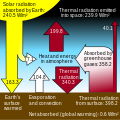Fișier:Greenhouse Effect.svg

Mărimea acestei previzualizări PNG a acestui fișier SVG: 600 × 600 pixeli. Alte rezoluții: 240 × 240 pixeli | 480 × 480 pixeli | 768 × 768 pixeli | 1.024 × 1.024 pixeli | 2.048 × 2.048 pixeli | 960 × 960 pixeli.
Mărește rezoluția imaginii (Fișier SVG, cu dimensiunea nominală de 960 × 960 pixeli, mărime fișier: 7 KB)
Istoricul fișierului
Apăsați pe Data și ora pentru a vedea versiunea trimisă atunci.
| Data și ora | Miniatură | Dimensiuni | Utilizator | Comentariu | |
|---|---|---|---|---|---|
| actuală | 23 iunie 2023 18:12 |  | 960x960 (7 KB) | Efbrazil | thermal radiation --> longwave radiation as per discussion |
| 22 mai 2023 19:09 |  | 960x960 (7 KB) | Efbrazil | graphical tweaks | |
| 19 mai 2023 23:00 |  | 960x960 (7 KB) | Efbrazil | Further tweak to word wrap | |
| 19 mai 2023 20:56 |  | 960x960 (7 KB) | Efbrazil | Graphic enhancements, content unchanged | |
| 11 mai 2023 21:05 |  | 960x960 (7 KB) | Efbrazil | Updating diagram to be based on newer data here: https://www.nasa.gov/feature/langley/what-is-earth-s-energy-budget-five-questions-with-a-guy-who-knows | |
| 31 august 2021 23:04 |  | 750x577 (21 KB) | Dragons flight | Revert to earlier version. Change is technically inaccurate. Energy flow balance requires that all forms of energy transfer are included, i.e. the land->atmosphere flow includes not only radiation but also conduction, convection, etc. Also, "heat radiation" appears to be colloquial. | |
| 23 august 2021 00:35 |  | 750x577 (21 KB) | Efbrazil | All heat radiation is now the same color, it is not clear why that was not the case before | |
| 22 august 2021 23:31 |  | 750x577 (21 KB) | Efbrazil | A few text changes to make things more clear | |
| 9 aprilie 2020 20:42 |  | 750x577 (21 KB) | Efbrazil | Minor edit, improving alignment of text with larger font for thumbnail view | |
| 30 martie 2020 20:06 |  | 750x577 (21 KB) | Efbrazil | Improved fonts and alignment for thumbnail legibility |
Utilizarea fișierului
Următoarele pagini conțin această imagine:
Utilizarea globală a fișierului
Următoarele alte proiecte wiki folosesc acest fișier:
- Utilizare la af.wikipedia.org
- Utilizare la beta.wikiversity.org
- Utilizare la bg.wikipedia.org
- Utilizare la ca.wikipedia.org
- Utilizare la da.wikipedia.org
- Utilizare la de.wikipedia.org
- Utilizare la diq.wikipedia.org
- Utilizare la en.wikipedia.org
- Causes of climate change
- Greenhouse effect
- Climate change
- User:Rugby471/Images
- Urban metabolism
- Talk:Greenhouse effect/Archive 3
- Wikipedia:Valued picture candidates/The Greenhouse Effect
- Wikipedia:Valued picture candidates/September-2009
- Wikipedia:Reference desk/Archives/Science/2009 December 6
- Talk:Greenhouse gas/Archive 4
- Talk:Climate change/Archive 63
- User:Bluebolt94/greenhouse
- Talk:Greenhouse gas/Archive 5
- User talk:JRSpriggs/Archive 5
- Wikipedia:Top 25 Report/November 10 to 16, 2013
- Wikipedia:Top 25 Report/November 17 to 23, 2013
- Wikipedia:Reference desk/Archives/Science/2017 November 14
- User talk:A loose necktie
- User:Daniel Mietchen/gallery
- Talk:Climate change/Archive 81
- Portal:Climate change
- Talk:Greenhouse effect/Archive 7
- Utilizare la en.wikibooks.org
- Utilizare la en.wikiversity.org
- Utilizare la es.wikipedia.org
- Utilizare la fa.wikipedia.org
- Utilizare la fr.wikipedia.org
- Utilizare la ga.wikipedia.org
- Utilizare la hu.wikipedia.org
- Utilizare la it.wikipedia.org
- Utilizare la ko.wikipedia.org
- Utilizare la lt.wikipedia.org
Vizualizați utilizările globale ale acestui fișier.
































